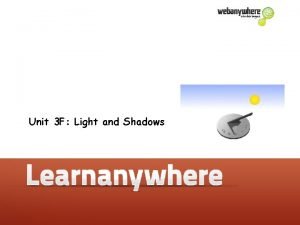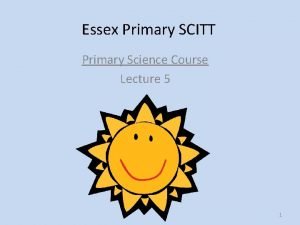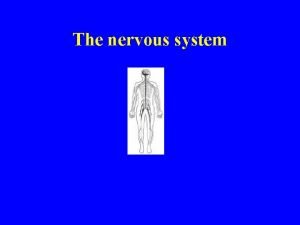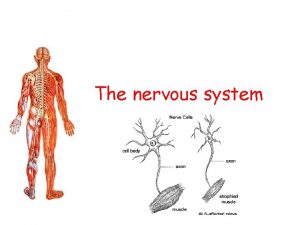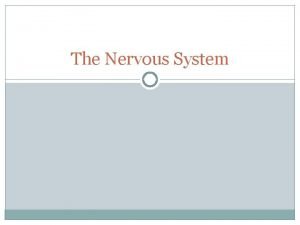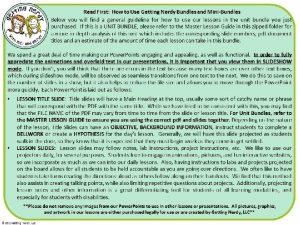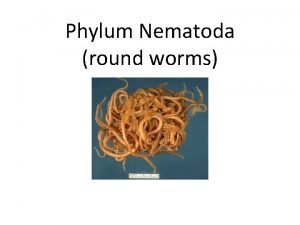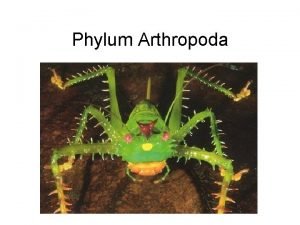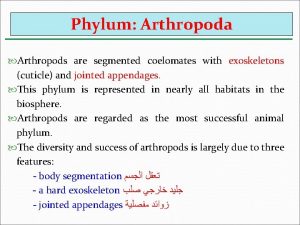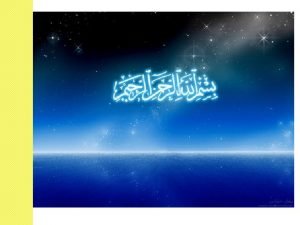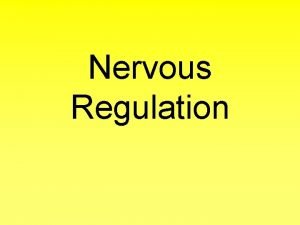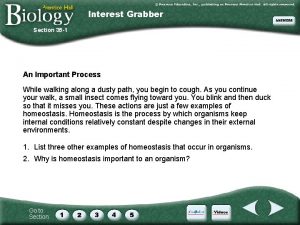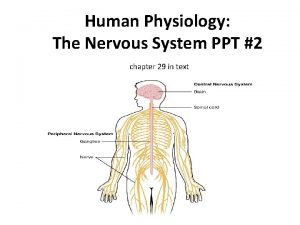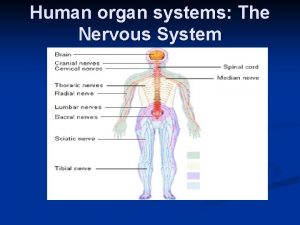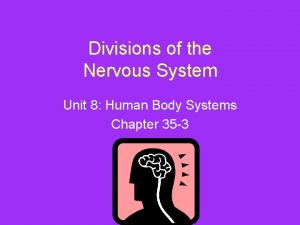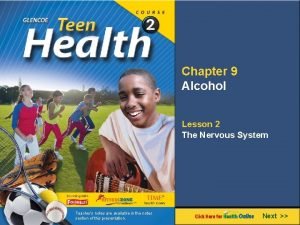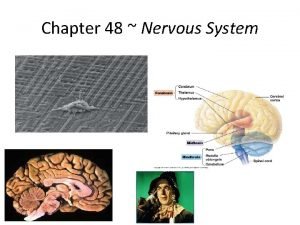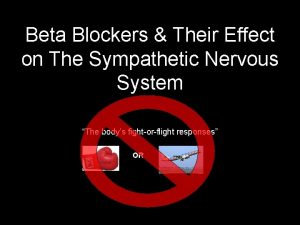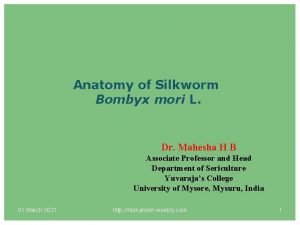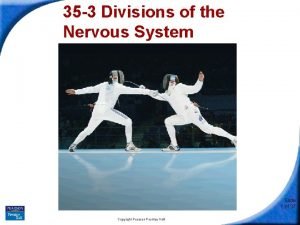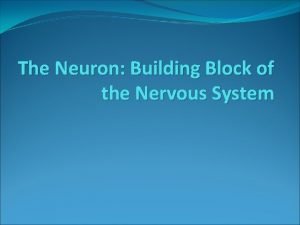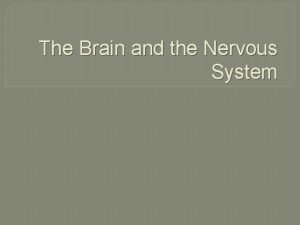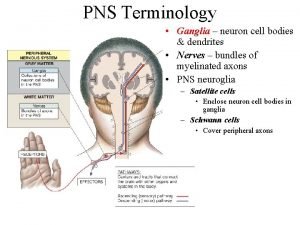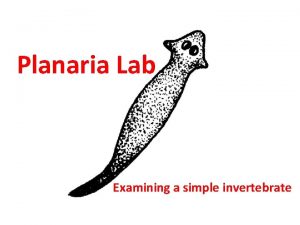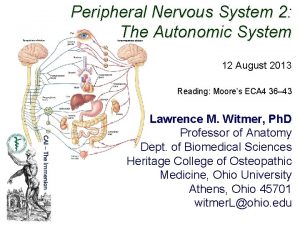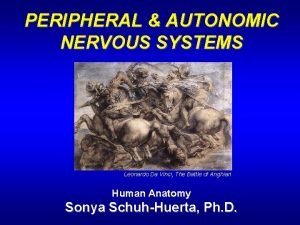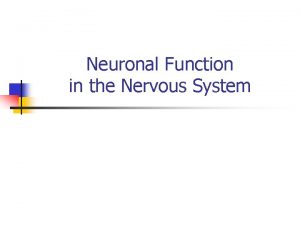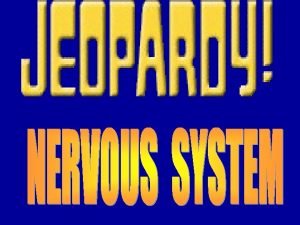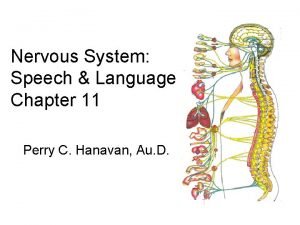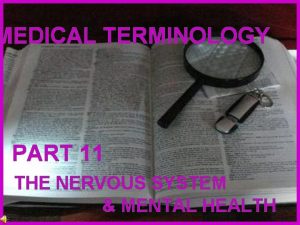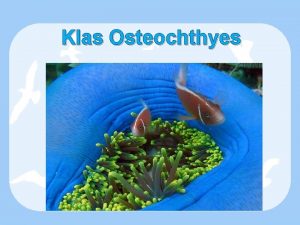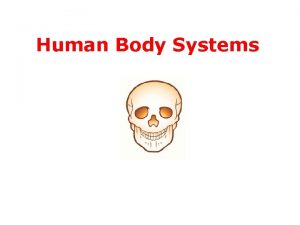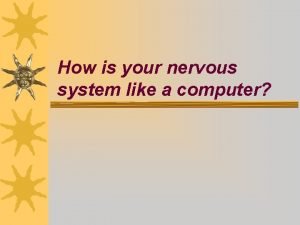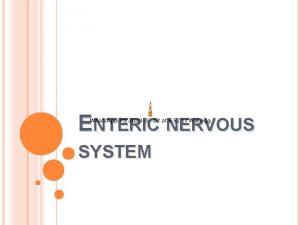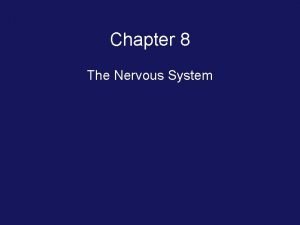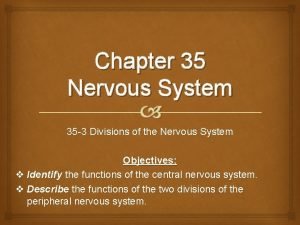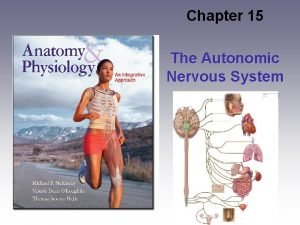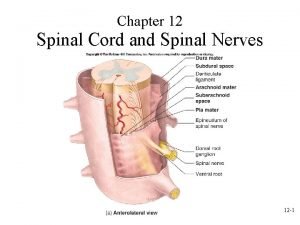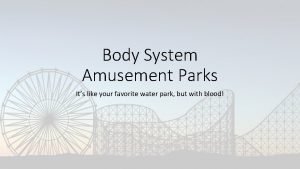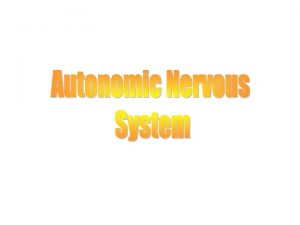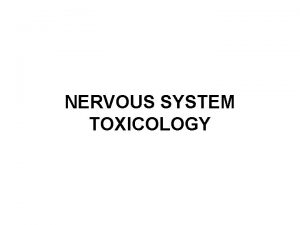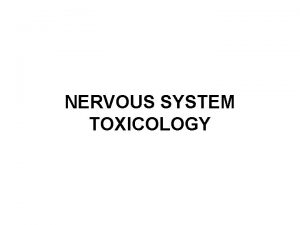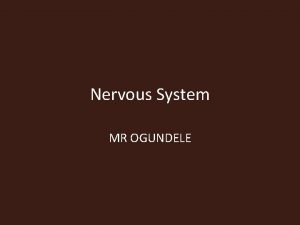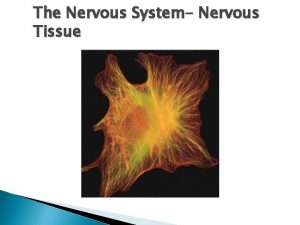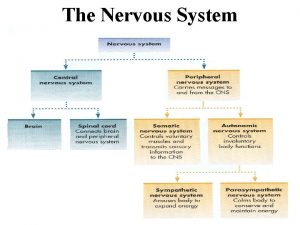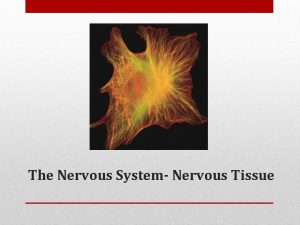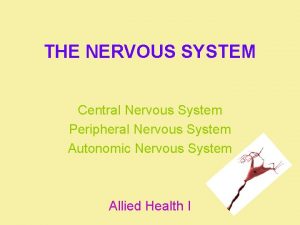THE NERVOUS SYSTEM Day 3 Study the pictures













































































- Slides: 77

THE NERVOUS SYSTEM

Day 3

Study the pictures below and answer the questions that follow. http: //www. abc. net. au/reslib/200712/r 213478_823745. jpg / http: //www. flickr. com/photos/14654539@N 03/1507069003

Warm up Q: Which systems in our body are at work when we play a sport? A: Our skeletal, muscular and nervous systems Q: How do we know when and where to move to during a sport? A: Our nervous system helps us to react to our surroundings and move according.

Activity • Using pipe cleaners, create a neuron using handout

Structures and Function of the NERVOUS SYSTEM Neurons

Nervous Tissue 2 Types- Neuroglia 4 Types of glial cells Neuroglia • Astrocytes- metabolic and structural support. • Specialized cells • Microglia- remove that do all the debris and attack support activities of microbes. the nervous system. • Ependymal cells- • Lining and covering cover the surface and cavities lines cavities of the nervous system. • Supporting and • Olingodendrocytesprotecting hold nerve fobers structures. together and make a lipid insulation called myelin

NERVE Tissue-Neuron • A group of cells that carry out all of the control functions of the nervous system. • Each part of neuron has specific function: – Cell Body: (Soma)cell metabolism – Dendrites: (fingers) receives information from the environment. More than one on each nerve cell. Carries impulse to cell body – Recievers – Axon: (Tail) generates and sends signals to other cells. Single long arm of the neuron. Carries impulses away from the cell body. – Axon terminal: (Cups) where signal leaves cell. Transmitters – Synapse: space that separates the axon of one neuron from the dendrite of the next.

NERVE Tissue-Neuron

NERVE Tissue-Neuron • Myelin Sheathinsulating fatty layer covering axon.

Nerve Impulse 1. In order for the nerve impulse to begin it must be initiated by a stimulus 2. The impulse travels into the neuron on the dendrite. 3. Goes through the cell body to the axon. 4. At the end of the axon a neurotransmitter is released. 5. The impulse is carried across the synapse to the next dendrite.

NERVE CELL/Neuron - form a network throughout our body - send messages to our body parts and receive messages from our surroundings through the spinal cord - connected end to end and transmit electrical impulses from one point to another

Neurotransmitters Acetycholine- In skeletal muscles neuromuscular junctions and ANS synapses. Norepinephrine- Visceral and cardiac muscle synapses and ANS. Epinephrine- In pathways that affect behavior and mood.

Neurotransmitters Serotonin- In pathways that regulate temp. sensory perception, mood and onset of sleep. Endorphins- Inhibit the release of pain transmitters.

Divisions of the Nervous System • Central Nervous System- Brain and spinal cord • Peripheral Nervous System-Cranial Nerves and spinal nerves. • Autonomic Nervous System- Includes the peripheral nerves and ganglia, supplies heart muscle, smooth muscle, secretory glands and involuntary action.

Processing • http: //www. youtube. com/watch? v=J 2 wn. Rk. Ruk 1 o • http: //www. youtube. com/watch? v=GIGqp 6_PG 6 k &feature=related • http: //www. youtube. com/watch? v=40 EBLb 1 avh M&feature=related • Gifted Hands

Day 4 The Brain

Warm Up 1 • What part of the nervous system contains the brain and spinal cord? • What carries messages to the cell body? • What is the nerve cell called? • What is the long arm of the nerve cell called? • For a nerve impulse to begin, it must be initiated by what? • What can a nerve cell have more than one of? • What is the space called separating the axon of one nerve cell from the dendrite of another?

The Brain • • 3 lb mass of soft nervous tissue. 100 billion neurons. soft organ that is protected by the skull Adequate blood supply is needed, brain tissue will die in 4 -6 min. • controls the entire nervous system - Divided into 4 major parts: cerebrum, diencephalon, cerebellum, and brain stem.

Meninges Tough fluid filled membrane that surrounds the brain and spinal cord 1. Dura Mater- outer brain covering, lines the inside of the skull, tough, dense fibrous connective tissue. 2. Subdural space- between dura mater and arachnoid. 3. Arachnoid- middle layer, resembles fine cobwebs. 4. Pia Mater- Inner most layer- covers the brain’s surface, comprised of blood vessels held together by connective tissue.

• Cerebral Spinal Fluid- Acts a a liquid shock absorber and source of nutrients for the brain and spinal cord. Forms in the ventricles of the brain. Clear fluid.

CEREBRUM - Largest part of the brain - makes up 85% of the brain's weight - thinking part of the brain -Maintains consciousness, mental processing and normal speech. -controls our voluntary muscles (the ones that move when you want them to) -Divided into right and left hemispheres by a deep groove( longitudinal fissure. -Convolutions- elevated folds on the surface of the cerebrum, they increase the surface area of the brain. -Sulci- fissure or grooves separating cerebral

Cerebrum Divided into 4 lobes • Frontal Lobe-conscious thought; damage can result in mood changes, social differences, • Parietal Lobe-integrating sensory information from various senses, and in the manipulation of objects • Temporal Lobe-senses of smell and sound, as well as processing of complex stimuli like faces and scenes. • Occipital Lobe-sense of sight; lesions can produce hallucinations

THE BRAIN: Cerebrum http: //health. allrefer. com/pictures-images/left-cerebral-hemisphere-function. html

THE BRAIN: Cerebrum http: //health. allrefer. com/pictures-images/right-cerebral-hemisphere-function. html

CEREBELLUM - Second largest part of the brain. - Located behind the pons and below the cerebrum. - Composed of 2 hemispheres - only 1/8 of the size of the cerebrum - Controls all body functions related to skeletal muscles including: balance, movement, muscle tone, smooth coordinated movement (how muscles work together) as well as posture.

THE BRAIN: Cerebellum http: //health. allrefer. com/pictures-images/cerebellum-function. html

BRAIN STEM • sits beneath the cerebrum and in front of the cerebellum-Made up of pons, medulla and midbrain. - it connects the rest of the brain to the spinal cord, which runs down our neck and back- ascending and descending tracts. - it sorts through millions of messages that the brain and the rest of the body send back and forth - controls our involuntary muscles (the ones that work automatically, without you even thinking about it)

Brain Stem • Pons- in front of the cerebellum, between the midbrain and medulla- contains center that controls respiration. • Midbrain- controls vision and hearing. • Medulla Oblongata- bulb shaped structure between the pons and the spinal cord. Controls heart rate and blood pressure.

THE BRAIN: Brain Stem http: //health. allrefer. com/pictures-images/brainstem-function. html

Ventricles of the Brain • The brain contains 4 cavities filled with cerebral spinal fluid called cerebral ventricles. • Right and left lateral ventricles • Third ventricle • Fourth ventricle- below the third ventricle. Choroid Plexus- network of blood vessels lining the ventricles which helps in the formation of CSF. Blood brain barrier- choroid plexus capillaries prevent substances like drugs from penetrating brain tissue- it makes infections like meningitis difficult to cure


Diencephalon • Located between cerebrum and midbrain • Composed of Thalamus and Hypothalamus – controls body temperature - if we feel warm, the hypothalamus tells the body to produce sweat. If we’re too cold, the hypothalamus gets us shivering - When you have an infection that causes a fever, the hypothalamus resets the body temperature to a higher temperature. That is why you shiver. - Autonomic Nervous control - Appetite control - Emotional State - Sleep control


THE BRAIN: Hypothalamus and Pituitary gland http: //www. besthealth. com/besthealth/bodyguide/reftext/images/Pituitary. Gland. jpg

Processing • Brain Bank- http: //www. youtube. com/watch? v=Z 59 hw. We. Vt. O Q • Labeling Activities 2, 3 and Parts of the Brain Labeling

Day 5 Spinal cord and spinal nerves

Warm up 2 • What are the 4 fluid filled cavities of the brain called? • What fluid is called the shock absorber? • What does the choroid plexus do? • What 3 important body functions does the medulla control? • What is the largest part of the brain? • What is the second largest part of the brain? • What structure of the brain controls coordination? • What is the Pia Mater? • What part of the brain maintains conciousness, mental processing and normal speech? • What controls temperature regulation?

Activity • Using a balloon and permanent marker, draw a face then the 2 sides of the brain labeling it and the functions of each structure.

Thalamus • The thalamus is involved in several functions of the body including: • Motor Control • Receives Auditory, Somatosensory and Visual Sensory Signals • Relays Sensory Signals to the Cerebral Cortex • Controls Sleep and Awake States

Amygdala: • The amygdala is an almond shaped mass of nuclei located deep within the temporal lobe of the brain. It is a limbic system structure that is involved in many of our emotions and motivations, particularly those that are related to survival. The amygdala is involved in the processing of emotions such as fear, anger and pleasure. The amygdala is also responsible for determining what memories are stored and where the memories are stored in the brain.

Basal Ganglia • Located at the base of the forebrain and strongly connected with the cerebral cortex, thalamus and other brain areas. The basal ganglia are associated with a variety of functions, including voluntary motor control, procedural learning relating to routine behaviors or "habits, " eye movements, and cognitive, emotional functions.

Hippocampus • The hippocampus is a small organ located within the brain's medial temporal lobe • The hippocampus is associated mainly with memory, in particular long-term memory. The organ also plays an important role in spatial navigation and behavioral inhibitions


Wernickle’s Area • Wernicke's area is the region of the brain that is important in language development. The Wernicke's area is located on the temporal lobe on the left side of the brain and is responsible for the comprehension of speech

Broca’s Area • Broca's area is a functionally defined structure in the left frontal lobe. It is involved mainly in producing speech, writing, and also in language processing and comprehension.


SPINAL CORD - about 18 inches long, begins at the foramen magnum - and continues down to the 2 nd lumbar vertebrae. located inside the vertebral canal Protected by the vertebral column Provides attachment points for the muscles of the back and ribs Has vertebral disks o which absorb shock during activities o allow spine to flex and extend Functions • Conduction pathway to and from the brain. • Reflex center

SPINAL CORD

Peripheral Nervous System • All the nerves of the body and ganglia. • Autonomic nervous system is a specialized part of the PNS. Nerves • Bundle of nerve fibers enclosed by connective tissue. • Sensory nerves carry impulses to the brain and spinal cord. • Motor nerves carry impulses to muscles or glands • Mixed nerves contain both sensory and motor fibers.

Path of messages in our nervous system The sensory nerves pick up the message from a stimulus. Message is sent as a nerve impulse. The sensory nerves bring the message to the spinal cord and brain. The brain receives the message & gives a response message through the motor nerves. The motor nerves help the muscles to carry out the response action.


I. III. IV. V. Cranial Nerves- 12 pairs Olfactory- smell Optic- vision Oculomotor- eye movement Trochlear- eye movement Trigeminal- Receives sensation from the face and innervates the muscles of mastication VI. Abducens- abducts the eye. VII. Facial- facial expression, sense of taste, salivary and lacrimal glands. VIII. Vestibulocochlear- sound, direction and balance. IX. Glossopharyngeal- taste, tonsil sensation, parotid glands X. Vagus- laryngeal and pharyngeal muscles controls muscles for voice and resonance and the soft palate. swallowing XI. Accessory- controls the sternocleidomastoid and trapezius muscles. Overlaps function of vagus nerve. XII. Hypoglossal-Tongue movement, swallowing, speech articulation.

Spinal Nerves • Originates in the spinal cord and go through openings in vertebrae. • 31 pairs • All are mixed nerves. • Named in relation to their location on the spine.

Autonomic Nervous System • ANS affects heart rate, digestion, respiratory rate, salivation, perspiration, diameter of the pupils micturition (urination), and sexual arousal. • Whereas most of its actions are involuntary, some, such as breathing, work in tandem with the conscious mind.

Autonomic Nervous System • Sympathetic Nervous System- the “fight or flight” system. • When the body perceives danger, the SNS sends a message to the adrenal medulla to secreate adrenaline- it increases the heartbeat. • stimulates heartbeat • raises blood pressure • dilates the pupils • dilates the trachea and bronchi • stimulates glycogenolysis — the conversion of liver glycogen into glucose • shunts blood away from the skin and viscera to the skeletal muscles, brain, and heart • inhibits peristalsis in the gastrointestinal (GI) tract • inhibits contraction of the bladder and rectum

• • • Parasympathetic Nervous System- Vagus Nerve slowing down of the heartbeat lowering of blood pressure constriction of the pupils increased blood flow to the skin and viscera peristalsis of the GI tract


Processing • Nervous System WS • Teamwork- Each table is to develop a mneumonic for the cranial nerves. Share at the end of class • Nervous System Crossword

Day 7 Common Nervous System Disorders

Warm up 3 Look up Disorders in textbook and fill out WS. • How many cranial nerves do you have? • How many pairs of spinal nerves do you have? • What are the 2 divisions of the ANS and what does each do? • What is the fight or flight syndrome and what activates it? • What are the structures of the central nervous system?

DISORDERS OF THE NERVOUS SYSTEM

Add to Worksheet

ALZHEIMER’S DISEASE Description/s marked by a deterioration of memory, thinking, and reasoning usually occurs in old age. Nerve endings in cortex of brain degenerate and block signals that pass between nerve cells. Cause is unknown. Stage 1 -(2 -4 yrs)- confusion, short term memory loss, anexity, poor judgement. Symptoms Stage 2 - (2 -10 yrs)- increase in memory loss, difficulty recognizing people, motor problems, logic problems, loss of social skills. Stage 3 -(1 -3 yrs)- aphasia, inability to recognize oneself, wt. loss, coma. Cure currently no cure for AD

Cerebral Palsy Description/s Cerebral palsy, also referred to as CP, is a term used to describe a group of chronic conditions affecting body movement and muscle coordination. It is caused by damage to one or more specific areas of the brain, usually occurring during fetal development; before, during, or shortly after birth; or during infancy. Infants with cerebral palsy are frequently slow to reach Symptoms developmental milestones, such as learning to roll over, sit, crawl, smile, or walk. This is sometimes called developmental delay. Some affected children have abnormal muscle tone. Cure No treatment- only management- Management consists of helping the child achieve maximum potential in growth and development. This should be started as early as possible with identification of the very young child who may have a developmental brain disorder.

EPILEPSY Description/s Uncontrolled electrical activity of neurons in the brain. Diagnosed by EEG. Seizures believed to be a result of spontaneous, uncontrolled electrical activity of neurons. Marked by seizures that often involve convulsions or the Symptomsloss of consciousness. Grand Mal-severe convulsive seizure. Petit Mal- Mild seizure activity. Can appear to be daydreaming. Rx is a recurrent, lifelong condition that must be managed on a long-term basis. Controlled by medication. http: //www. youtube. com/watch? v=MRZY 2 a 2 jnuw&feature=re lated

HUNTINGTON’S DISEASE Description/s Inherited, progressive disease Symptoms usually appear in people between the ages of thirty and fifty -uncontrollable physical movements and mental deterioration. Symptoms -include restlessness, twitching, and a desire to move about Rx there is no cure for HD and no treatment that can slow its rate of progression

Meningitis Description/s Inflammation in the lining of the brain and spinal cord. May be bacterial or viral. Severe headache, fever, stiff neck, nausea and vomiting. In severe cases may lead to paralysis, coma and death. Symptoms Test to diagnosis is lumbar puncture to test cerebrospinal fluid. Rx If bacterial treat with antibiotics. Viral it has to run it’s course. Vaccine for bacterial meningitis

MIGRAINE -a particularly intense form of headache lasting several hours or more Description/s -headaches are provoked by a particular stimulus, such as stress, loud noises, missed meals, or eating particular foods. Headaches, nausea, sensitivity to light and/or Symptoms sound Rx Several drugs may be used to reduce the pain and severity of a migraine attack.

MULTIPLE SCLEROSIS Description/s -occurs when the myelin sheath (a protective coating around the nerves) deteriorates. The nerves become exposed and this directly interferes with the way that the brain sends signals to the rest of the body. The exposed nerves become hardened (sclerosis) and means that the body cannot respond to the signals being sent by the brain. -severe exhaustion, bladder and bowel weakness, balance and co-ordination problems, dizziness, Symptoms vision problems and pain in eyes, muscle stiffness, weakness, cramps and pain Rx -it is thought that viral or bacterial infections can trigger the immune system to attack itself -no known cure for MS, and treatment involves a management of the symptoms

Paralysis/ Spinal Cord Injury -Paralysis is most often caused by damage or break in Description/s the central nervous system, especially the spinal cord with complete or partial loss of muscle function in one or more muscle groups. Other major causes are stroke, trauma with nerve injury -Leaking of spinal fluid at injury site Symptoms Rx inability to move muscles depending on what level of injury to spinal cord or disease. Paraplegia- When only the lower limbs are affected by paralysis Qudraplegia- When all four limbs are affected – can cause respiratory paralysis. Hemiplegia- When only one side of the body is affected -Automonic dysreflexia, Bladder management, Bowel care, Depression, Pain, Respiratory health, Sexual health, Skin care, Spasticity, Physical and occupational therapy.

PARKINSON’S DISEASE Description/s -progressive disease in which cells in one of the movement-control centers of the brain begin to die, resulting in a loss of control over speech and head and body movements -nerves and muscles become weak, and the control over speech and head and body movements is lost -symptoms include tremors (usually beginning in the Symptoms hands), shuffling gait, slow movements, muscle rigidity or stiffness, balance problems, decreased eye-blinking, depression, speech changes, sleep problems, constipation, and irritability, shuffling gait Rx There is currently no cure for or a way to prevent PD

POLIOMYELITIS (Polio) Description/s -serious infectious viral disease that attacks muscle-controlling nerves and can eventually cause paralysis -affects children -spreads primarily through contact with saliva or feces of infected person. The virus enters the and multiplies rapidly in the intestines. Eventually it enters the bloodstream, then gains access to the central nervous system. Rare in the U. S. due to vaccinations. -symptoms are fever, sore throat, vomiting, Symptoms diarrhea, stiff neck and back, and muscle pain Rx vaccines were developed to provide the body immunity to the poliomyelitis virus

STROKE (Cerebral Vascular Accident) -occurs when a blood vessel carrying oxygen and Description/s nutrients to the brain is either blocked by a blood clot or bursts (caused by elevated blood pressure) -part of the brain is deprived of the blood and oxygen it needs, so it begins to die, tissue death. Third leading cause of death in the U. S. Hemiplegia-weakness or numbness of one side of the face, arm and/or leg; sudden severe headache, Symptoms dizziness, Sudden loss of vision in one eye, dysphagia, trouble speaking or understanding; trouble walking or loss of balance, coma and possible death. Rx Get to hospital immediately!!! CT done to determine cause. If clot is noted, treated with clot dissolvers- heparin.

West Nile Virus -West Nile virus is an arthropod-borne virus (arbovirus) Description/s most commonly spread by infected mosquitoes. -70 -80% of all people infected will not develop symptoms. About 1 in 5 people who are infected will Symptoms develop a fever with other symptoms such as headache, body aches, joint pains, vomiting, diarrhea, or rash. Most people with this type of West Nile virus disease recover completely, but fatigue and weakness can last for weeks or months. Rx There are no medications to treat or vaccines to prevent WNV infection

Processing • Nervous System Study Guide, Disorders Word Scramble, Medical Terminology Handout • Study for test on Friday

Processing • http: //www. youtube. com/watch? v=z. Eq 9 jd. H 2 Et. M • http: //www. youtube. com/watch? v=f. Kr. XCly 1 k. K 0 &feature=related • http: //www. youtube. com/watch? v=y. XONEHmup y 0&feature=related • http: //www. youtube. com/watch? v=if. Dglts. L 2 FU& feature=related
 Day 1 day 2 day 3 day 4
Day 1 day 2 day 3 day 4 Neuron process
Neuron process Sensory input and motor output
Sensory input and motor output Processes of a neuron
Processes of a neuron Day 1 day 2 day 817
Day 1 day 2 day 817 Nervous system and digestive system
Nervous system and digestive system Endocrine system vs nervous system
Endocrine system vs nervous system Mechanism of hormone action
Mechanism of hormone action Endocrine system
Endocrine system Columbia pictures universal pictures
Columbia pictures universal pictures Columbia pictures 20th century fox paramount pictures
Columbia pictures 20th century fox paramount pictures Pictures of shadows at different times of the day
Pictures of shadows at different times of the day Www.youtube.com
Www.youtube.com Chemical messengers of the nervous system
Chemical messengers of the nervous system Flatworm labeled
Flatworm labeled The nervous system is made up of
The nervous system is made up of Primary functions of the nervous system
Primary functions of the nervous system Learning objectives of nervous system
Learning objectives of nervous system Chapter 7 the nervous system
Chapter 7 the nervous system What is stimuli in nervous system
What is stimuli in nervous system Nervous system objectives
Nervous system objectives Craniosacral region
Craniosacral region Autonomic nervous system def
Autonomic nervous system def Cervical nerve exit
Cervical nerve exit Sns pg
Sns pg Brain scienstructable
Brain scienstructable Skeletal muscle autonomic nervous system
Skeletal muscle autonomic nervous system Nematoda
Nematoda Meristomata
Meristomata Arthropods structure
Arthropods structure Nervous system of arthropods
Nervous system of arthropods Central and peripheral nervous system
Central and peripheral nervous system Parasympathatic
Parasympathatic Nervous system of coelenterata
Nervous system of coelenterata Autonomic nervous system consists of
Autonomic nervous system consists of The body's speedy electrochemical communication network
The body's speedy electrochemical communication network Section 35-1 human body systems answer key
Section 35-1 human body systems answer key Ans
Ans Brain layer
Brain layer Basic unit of nervous system
Basic unit of nervous system Homeostasis positive feedback examples
Homeostasis positive feedback examples Histology of cns ppt
Histology of cns ppt Grey matter reliaquest
Grey matter reliaquest Comparison of endocrine and nervous system
Comparison of endocrine and nervous system 8 divisions of the nervous system
8 divisions of the nervous system How to take care of your nervous system
How to take care of your nervous system Effector cells nervous system
Effector cells nervous system Chapter 15 nervous system diseases and disorders
Chapter 15 nervous system diseases and disorders Are endocrine glands ductless
Are endocrine glands ductless Beta-blockers for overactive sympathetic nervous system
Beta-blockers for overactive sympathetic nervous system Hypothalamus
Hypothalamus Autonomic
Autonomic Digestive system of bombyx mori
Digestive system of bombyx mori Section 35-3 divisions of the nervous system
Section 35-3 divisions of the nervous system What is the basic building block of the nervous system
What is the basic building block of the nervous system Structure of nervous system graphic organizer
Structure of nervous system graphic organizer Medunerve
Medunerve Planaria classification
Planaria classification Cnidarian digestive system
Cnidarian digestive system The difference between sympathetic and parasympathetic
The difference between sympathetic and parasympathetic Sympathetic and parasympathetic nervous system difference
Sympathetic and parasympathetic nervous system difference Nervous
Nervous Divisions of the nervous system
Divisions of the nervous system Language
Language Nervous tissue
Nervous tissue Disorders of the nervous system
Disorders of the nervous system Osteichthyes nervous system
Osteichthyes nervous system Smoking damages your lungs
Smoking damages your lungs Nervous system of computer
Nervous system of computer Enteric plexus
Enteric plexus Sella turcica
Sella turcica Chapter 8 the nervous system
Chapter 8 the nervous system Nervous system
Nervous system 35-3 divisions of the nervous system
35-3 divisions of the nervous system Autonomic nervous system
Autonomic nervous system Functional unit of nervous system
Functional unit of nervous system Body system amusement park
Body system amusement park The autonomic nervous system controls
The autonomic nervous system controls











